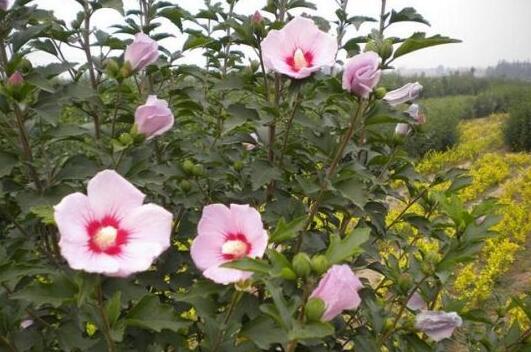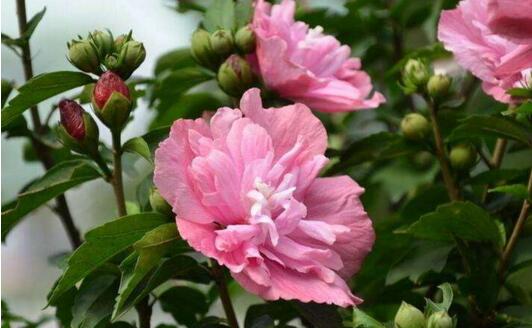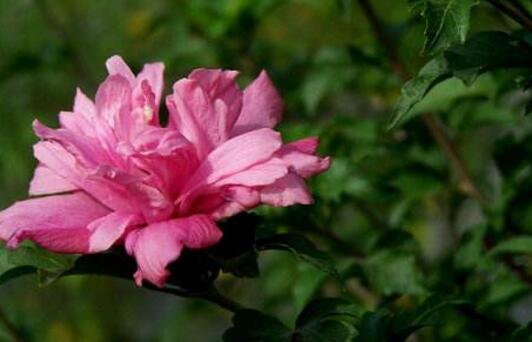How to fertilize hibiscus flowers, fertilization methods / nutritional balance of hibiscus flowers should not be excessive.
Fertilization, like watering, is very important in hibiscus cultivation methods, and when fertilizing, the choice of fertilizer and the amount of fertilizer need to be considered, so how to fertilize hibiscus flowers is more scientific? Let's take a look at the fertilization methods of hibiscus flowers.
How to fertilize hibiscus flower

The principle of fertilization is not only to provide the nutrients needed for the growth of hibiscus flowers, but also to promote its growth, germination and flowering, so the fertilizers applied will be different at different growth stages. How can hibiscus flowers be fertilized? Here are the specific methods.
Fertilization methods of hibiscus flower
1. When putting on the basin
When putting on the basin, it should be in the bottom of the basin or in the soil if the base fertilizer. As hibiscus flowers do not require high acidity and alkalinity of the soil, the base fertilizer can be safely applied and can be made from a mixture of rotten livestock manure and compound fertilizer.
2. After germination
After germination, hibiscus flowers will enter a period of vigorous growth, which is usually in the middle and late April, when it is mainly quick-acting fertilizer, which can ensure that the buds can absorb sufficient nutrients more quickly, promote the healthy growth of hibiscus flowers and make the leaves more green.
3. Before flowering
Phosphate fertilizer can be applied before flowering, which can promote flowering, make the flowers more colorful, and allow some weaker plants to sprout flowers and branches.
4. When in bloom
When flowering, you need to reduce fertilization, generally once every two months, fertilizer is mainly compound fertilizer, so that the flowering period can be prolonged and the viewing time can be longer.
5. After the flowers fade
After the flowers wither naturally, the temperature will gradually drop, and the hibiscus flower will slowly enter the dormancy period in winter. Nitrogen fertilizer can be applied once before the beginning of winter to improve its resistance during the winter and help it survive the winter smoothly.
What if hibiscus flower fertilizes too much?
Do not apply too much fertilizer, and if you apply too much fertilizer, there are two ways to solve this problem. The first is to replace the basin soil, if there is too much fertilizer in the soil, it will cause fertilizer damage phenomenon, the replacement of basin soil is a more thorough solution.
The second method is to bury radish seeds around the roots, let the seeds absorb excess nutrients in the soil, pull them out when the seeds germinate, and pay attention to watering more when fertilizing too much.
How to raise hibiscus flowers, breeding methods and precautions of hibiscus flowers / water and fertilizer should not be excessive
We know that in the efficacy and function of hibiscus flower, it not only has high nutritional value, but also can treat many diseases, so there are many people who grow it, so how can hibiscus flower grow better? Let's take a look at the breeding methods and points for attention of hibiscus flowers.
How to raise hibiscus flowers
If you want to know the culture method of hibiscus flower, you must first understand its growth habits. Hibiscus flower is very adaptable to the environment, it has the characteristics of drought tolerance, shade tolerance, heat tolerance, cold tolerance, pruning resistance, moisture tolerance, poor soil resistance and so on, coupled with strong sprouting and tillering, so it is very easy to feed.
Hibiscus flower is suitable for the environment.
1. Soil
Hibiscus may have the most relaxed requirements for soil among plants. It can grow in heavy clay as well as poor soil, but it is better to use fertile, well-drained acidic soil to raise it better.
2. Temperature
Hibiscus flower has strong resistance to cold and heat, but it prefers warm environment, so in the breeding methods and precautions of hibiscus flower, the temperature of 18-25 degrees is the most suitable, when it grows the fastest, and the temperature should not be lower than 0 degrees in winter and no higher than 35 degrees in summer.
3. Lighting
Hibiscus flower has outstanding shade tolerance, it can grow normally in semi-shady environment, but it prefers the environment with plenty of light, the lack of light will cause its flowers to be dim and blossom less, so it should be kept in a bright place for maintenance. If it is in full light, it should be shaded in summer.
Culture methods of hibiscus flower
1. Watering
Hibiscus flowers are very resistant to drought and moisture, but in the process of breeding, the soil should be avoided to be too dry or often accumulate water, so when watering, keep the soil moist, not let it be too dry, and spray water on the leaves in summer.
2. Fertilization
Hibiscus flowers are fertilizer-loving plants, so how to grow hibiscus flowers when fertilizing? Attention should be paid to rational fertilization, such as topdressing phosphorus and potassium fertilizer before budding, which can promote its flowering and make the flower color more colorful, while nitrogen fertilizer should be applied during the growing period to provide nutrition for growth and make the leaves greener.
3. Pruning
When hibiscus flowers germinate in spring, they can be shaped and pruned, and in the spring of the second year after planting, they can be cut off to promote basal branches, so that hibiscus flowers can be cultivated into an ideal tree shape and have higher ornamental value. in the breeding methods and matters needing attention of hibiscus flowers, pruning is easy to be ignored.
Points for attention in raising hibiscus flowers
1. Turn the soil and change the basin
Whether it is open field cultivation or pot cultivation, it is necessary to turn the soil or change the pot regularly, generally every 1-2 years, in order to ensure the good air permeability and drainage of the soil, and to prevent the soil from being too barren to affect flowering.
2. Soil disinfection
Although hibiscus does not have high requirements for the soil, it is not completely without requirements, and the most important thing is that the soil must be healthy and free of germs and eggs, which requires disinfection of the soil before planting.
3. Water and fertilizer should not be too much.
No matter watering or fertilizing, we should pay attention not to over-watering. We should not pour a large amount of water because it is resistant to moisture, causing the roots to soak in the water for a long time, while too much fertilization will lead to leaf thickening and affect the formation of flower buds. This skillful practice is not advisable when planting hibiscus flowers.
How to grow potted hibiscus flowers
If it is a family potted hibiscus flower, in addition to understanding the above points, we also need to pay attention to the prevention and control of diseases and insect pests, and the way to prevent them is to keep the environment ventilated and clean, and to treat them with drugs in time when diseases and insect pests occur, so as to avoid the spread of harm.
How to reproduce hibiscus flower, the propagation method / cutting ramet of hibiscus flower is the most practical.
Hibiscus flowers grow very fast, so after raising hibiscus flowers for 3-4 years, flower friends need to consider the problem of reproduction. As a deciduous shrub, how can hibiscus flowers reproduce better? Let's take a look at the breeding methods of hibiscus flowers.
How do hibiscus reproduce?
The common propagation methods of hibiscus flower are sowing, cutting, ramet, grafting, striping, tissue culture, for ordinary flower friends, the more common methods are cutting, ramet and striping, so the following focus on these three methods.
I. split-plant propagation
1. Time
Ramet time is generally chosen in early spring, that is, before a large number of sprouts, when ramets are most suitable for climate.
2. Ramet method
In the same way as most plants, exuberant and healthy adult plants are dug out of the soil, and then planted at a certain density with one clump of every three plants. This method of propagation of hibiscus flower has the least effect on its growth.
II. Cutting propagation of hibiscus flower
1. Time
The time can be chosen in spring or autumn, and spring planting is usually the best, which can be combined with pruning in March to make it blossom smoothly in summer, thus giving full play to the efficacy and role of hibiscus flowers.
2. Methods
How do hibiscus flowers propagate when using cuttings? First of all, choose a good branch. Generally speaking, branches are selected from 1-2-year-old robust plants, preferably in an unsprouted state. If they have already sprouted or have grown leaves, the newly grown leaves can be removed.
The second is to cut the branches into small pieces. Cut the selected branches into 10-15 cm segments to make cuttings. Each cuttage should contain two leaves and full buds. The lower cut is preferably horseshoe-shaped, so that the buds are about 1 cm near the cut, and the upper and lower cuts are flat.
Finally, there is cutting. In the breeding method of hibiscus flower, cuttings are cut along with cutting, so when the cuttings are finished, they need to be cut immediately. The substrates used for cutting can choose peat soil, garden soil and so on. The looseness and fertility of the soil are conducive to rapid rooting and sprouting after cutting.
3. Management
Generally, there is no need to apply base fertilizer before cutting, it needs to maintain a certain amount of humidity after cutting, and it needs to be watered thoroughly when the cutting is finished, then put the hibiscus flower in a cool place, then cover it with plastic film and wait for three weeks to take root.
III. Striping propagation of hibiscus flower
1. Time. Striping propagation is usually selected in April, when the growth is more exuberant, after the striping will sprout more smoothly.
2. Methods. How do hibiscus flowers reproduce when striping is used? Select a 2-year-old sturdy branch, peel it in a ring 0.5 cm below the node, then wrap the peat soil in a plastic film, wrap it in the peeling place, and leave a water outlet at the upper end.
3. Maintenance. If the plastic film is too dry, it can be watered properly from the position of the water outlet to avoid stagnant water in the film. it usually takes 3 months from pressing to rooting, so it takes a certain amount of patience.
- Prev

How to water hibiscus flowers, do not dry, do not water / water thoroughly after drying / ensure that the soil is well drained
The drought tolerance of hibiscus flower is relatively strong, so watering should be paid attention to when planting it, and watering is also an important part of the breeding method of hibiscus flower, so how to water hibiscus flower is better? The editor came to tell you the answer.
- Next

What to do if the leaves of hibiscus flowers are yellow? there are five ways to improve the leaf yellow phenomenon / prescribe the right medicine.
Hibiscus is a perennial shrub, so its leaves should be evergreen, but some flower friends will also encounter the phenomenon of yellowing leaves when planting, which not only does not look good, but may also affect growth and flowering, so what if the leaves of hibiscus flowers turn yellow? The editor will tell you the method.
Related
- Fuxing push coffee new agricultural production and marketing class: lack of small-scale processing plants
- Jujube rice field leisure farm deep ploughing Yilan for five years to create a space for organic food and play
- Nongyu Farm-A trial of organic papaya for brave women with advanced technology
- Four points for attention in the prevention and control of diseases and insect pests of edible fungi
- How to add nutrient solution to Edible Fungi
- Is there any good way to control edible fungus mites?
- Open Inoculation Technology of Edible Fungi
- Is there any clever way to use fertilizer for edible fungus in winter?
- What agents are used to kill the pathogens of edible fungi in the mushroom shed?
- Rapid drying of Edible Fungi

